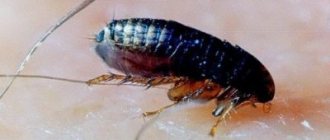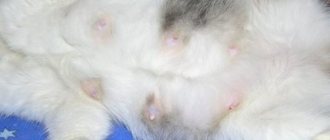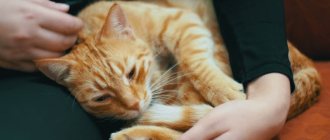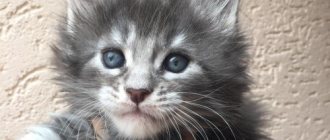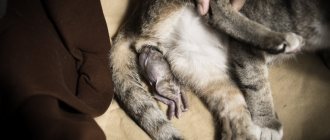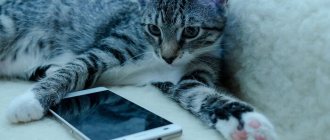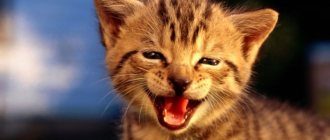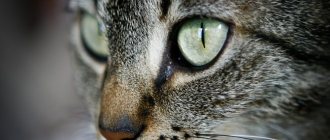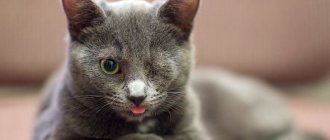A cat's third eyelid is a fold of the conjunctiva, which is located at the inner corners of the eyes. It plays a vital role in the functioning of the visual organs. When the animal blinks or tilts its head toward the surface, the third eyelid straightens and covers the entire visible surface of the eye. The nictitating membranes work like a windshield wiper blade in a car, distributing tear fluid evenly and removing foreign particles from the eyes. In addition, the nictitating membrane produces approximately one third of all tear fluid.
What is this third eyelid?
As the cat Matroskin said, “Whiskers, paws and tail - these are my documents!” And veterinarians might add: and the third eyelid. Because not all mammals have it.
Human ancestors once had a nictitating membrane, but now it is a small fold at the inner corner of the eye, called the lacrimal. In cats, the membrane opens and sometimes reaches the middle of the eye.
The third eyelid, or nictitating membrane, is a thin film (light, sometimes pigmented) in the corner of the cat's eye, which protects the mucous membrane from damage and dust. It secretes a little tear fluid, which, when blinking, wets the surface of the eyeball and thus collects foreign particles, trapping bacteria.
This fold of mucosa is covered with immune tissue. The complex structure of the structure ensures the distribution of tear fluid and antibodies throughout the cornea. Most of the eyelid is hidden in the eye socket and does not normally attract attention. The nictitating membrane in a cat usually attracts the attention of owners when there is an injury or infection.
A cat's third eyelid becomes covered with a film or falls out for several reasons, and it is difficult for a non-specialist to identify the nature of the damage. The cat hides from the light, often scratches its face, and experiences itching. An animal cannot help itself, so caring owners take this responsibility upon themselves.
Treatment of third eyelid adenoma
An adenoma is a benign neoplasm in the eye that is bright pink in color and has clear outlines. If measures are not taken, the tumor begins to grow, preventing the eyes from closing. The cat stops eating, becomes lethargic and apathetic.
An adenoma is a bright pink growth in a cat's eye.
Treatment may require surgical removal of the adenoma and nearby tissue. After which anti-inflammatory and antibacterial eye ointments and drops are prescribed.
Important. The animal's lacrimal gland or nictitating membrane should not be removed. This is fraught with serious complications: keratoconjunctivitis, ulcerative keratitis or complete blindness.
This pathology is treatable. But it will be very time-consuming and labor-intensive. It is strictly forbidden to straighten the eyelid on your own. All manipulations with the eyes of a sick cat should be carried out by a veterinarian.
Causes of third eyelid prolapse in cats
In healthy animals, the third eyelid is visible only when blinking and tilting the head. In pathological situations, the nictitating membrane is always noticeable - this is a reason to contact a veterinary clinic. The appearance of a nictitating membrane can lead to loss of vision and cause a number of serious diseases. In addition, the third eyelid causes discomfort to the cat and interferes with a normal view of the outside world.
Allergy
Allergic conjunctivitis is not always associated with food components or ordinary dust. Sometimes it occurs with sensitivity to sunlight and household chemicals (laundry powder or deodorants, human cosmetics, floor cleaners and room disinfectants).
Allergic redness of the third eyelid may be accompanied by swelling of the larynx, redness of the skin, and lethargy of the pet. It is possible to identify an allergen in the blood only in a hospital setting. Then everything depends on the scale of the lesion: for mild cases of the disease, Zyrtec, Fenistil, Kestin are used, that is, antihistamines. In severe cases, the veterinarian prescribes hormonal treatment: Dexamethasone, Prednisolone.
Parasitosis
If your cat has a third eyelid due to parasites, it will need to be rinsed with cleansing drops. When using gels and drops for inflammation, you need to make sure that the cat does not wipe them with its paws.
If the problem is fleas or worms, you can deal with it at home. Antihelminthic measures can be carried out without a doctor’s prescription if the cat is completely healthy and has no allergies or chronic diseases. Kittens, pregnant and weakened individuals must consult a veterinarian before deworming.
Fleas are most often driven out with a spray or drops on the withers. Anti-flea collars can be used as prevention.
Complex cases of infection are treated under the supervision of a veterinarian. Sometimes therapy lasting 1-2 months is required for complete recovery.
Adenoma
A benign tumor of the third eyelid is called an adenoma. Externally, it is a voluminous pink formation that prevents the cat from closing its eye. The disease is dangerous because there is a risk of injury to the cornea and secondary infection.
If the tumor grows and causes concern, it is removed in surgery, while trying to preserve the nictitating membrane itself to avoid dry eye, conjunctivitis and blindness.
Foreign body rejection
Often, lacrimation and prolapse of the third eyelid contribute to the natural rejection of insects, small particles of dust or sand, and other foreign bodies that have entered the eye. Indoor cats and those that are outdoors have approximately the same likelihood of such injuries. Often the usual copious rinsing leads to recovery.
If a secondary infection occurs, the cat will require treatment.
Injuries
Injuries to the delicate membrane in kittens occur during a period of rapid growth. Due to curiosity and childhood clumsiness, they can damage any part of the eyes.
Adult animals, as a rule, avoid eye damage in everyday life. Cats that go outside may get into fights or damage the fold while fleeing from dogs. Therefore, there should be increased monitoring of walking pets: after a long absence from home, you need to examine the cat as a whole.
If the bleeding of the membrane is slight and there are no moving torn fragments, the damage will heal on its own. The main thing is that the pet does not scratch the injury with its paws and does not introduce an infection into the wound.
Getting infected
Fungi, viruses, and bacterial infections are insidious in that they can lead to complete loss of vision. If because of them the cat has a third eyelid, a set of measures will be needed:
- antifungal injections;
- antibiotic drops;
- pain reliever;
- antipyretic;
- drinking plenty of water;
- vitamins;
- immunostimulants.
There are situations when microbes were “targeted” in the ear, but they also grabbed the eyes nearby, then, for example, otitis media and inflammation of the conjunctiva are treated at the same time. A veterinarian will help you prescribe the medicine and dosage correctly. Getting rid of the infection on your own will not bring results, but will only worsen the pet’s condition.
Anatomical disorders
The most common disorders - cartilage eversion and lacrimal gland prolapse - can only be treated surgically.
A natural predisposition to prolapse (loss) is expressed in British, Persian and exotic breeds. Prolapse refers to the loss of the normal position of the gland, the structure of the tissue does not change. It would be a mistake to confuse prolapse with an adenoma (neoplasm).
The tissues are sutured, since removing the eyelid will lead to the development of keratoconjunctivitis sicca. This is a chronic disease, and owners will have to monitor the cat's eyes for the rest of his life. Therefore, veterinarians try to preserve the cat’s nictitating membrane at all costs.
During eversion, the curved part of the cartilage is removed, and the decision about the operation is made by the doctor. It identifies potential risks and can make a more or less accurate forecast.
Other diseases
Some diseases of the internal organ systems can lead to loss or enlargement of the third eyelid. Typically, the disease is in its acute stage during the period when it can affect the eyes. This:
- chronic somatic diseases, for example, renal failure;
- hormonal imbalances;
- damage by viruses (distemper, leptospirosis);
- recovery from anesthesia after surgery.
Each of these conditions requires treatment of the underlying cause. Viruses are especially dangerous - they can cause rapid death.
Symptoms of hair loss
The emergence of the third eyelid beyond its normal boundaries, as well as its swelling, is a serious cause for concern. The non-physiological position of the membrane is a signal of certain diseases or injuries. In addition to the fact that the third eyelid becomes visually noticeable, other symptoms are noted. In cases where the causes of the unpleasant phenomenon are directly related to the eyes, redness of the conjunctiva occurs, the release of an increased amount of tear secretion, the appearance of purulent discharge in the corners of the eyes, and involuntary spasm of the orbicularis oculi muscle. A burning sensation in the eyes affects the cat's behavior. She tries to avoid the light and scratches her eyes with her paws.
If the problem is caused by systemic or infectious diseases, then the cat will exhibit symptoms characteristic of such conditions. These include general weakness, decreased activity, loss of appetite, and increased temperature. If the problems are related to the digestive tract, then frequent or episodic vomiting and diarrhea are possible. As the process drags on, the animal loses weight and the condition of its coat deteriorates. In rare cases (with Horner's syndrome), paralysis or paresis of the limbs and facial nerve occurs.
Sometimes third eyelid prolapse is confused with lacrimal gland prolapse because these conditions are visually similar. To distinguish these problem situations and understand the solutions, it’s worth watching this useful video:
How to recognize the problem
Depending on the cause of the nictitating membrane, the veterinarian will select therapy. Self-medication is dangerous and can make the situation worse. If treatment is not started in a timely manner and therapy is selected incorrectly, there is a risk of complications and even loss of vision.
Symptoms
Prolapse of the third eyelid is manifested by enlargement, often by redness of the fold (the so-called cherry eye), lacrimation, and sometimes purulent discharge. The animal squints, rubs its eyes with its paws or scratches its muzzle on everything, and washes itself endlessly.
If a cat has a noticeable third eyelid, then problems with the digestive system cannot be ruled out. Observe the animal; if the film does not hide back on its own for several days, this is a reason to consult a doctor. Another cause for concern is the onset of the flu, when the eyes fester and the temperature rises.
The third eyelid should not always alarm owners - there are cases of its appearance due to physiology.
Signs of eye diseases
Often cats with prolapse of the third eyelid experience lacrimation, the pet constantly washes itself, is bothered by itching, squints its eyes, and blinks frequently. With close observation, you may notice spasms of the periorbital muscle, redness and swelling of the conjunctiva, mucous or even purulent discharge from the affected eye. Volumetric formations appear in the inner corners of the eyes, and the temperature may rise.
Prolapse of the third eyelid is dangerous for the animal due to the addition of a secondary infection. Therefore, if this pathology is detected in a pet, it is necessary to urgently show it to a veterinarian.
When everything is within normal limits
Sometimes the third eyelid is shown briefly (without discoloration, foreign discharge, or signs of inflammation) when the animal is sleeping. Normally, the membrane is visible when the animal tilts its head. This does not indicate illness and should not cause concern.
A kitten's third eyelid is observed in the first weeks of life, until the eyes open completely. Then it “resets” itself to its normal state. But if the film stretches over half the eye or completely covers it, you need to monitor the general condition of the animal and, if you suspect a disease, contact a veterinarian.
Prolapse: treatment of the disease
With prolapse, the third eyelid covers half of the eye. This disease is often confused with hair loss. Their difference is the color of the conjunctiva. With prolapse, it has a gray or gray-blue tint. The cause may be an allergic reaction or a foreign body entering the mucous membrane of the eye.
Trying to get rid of unpleasant sensations, the cat rubs its eyes vigorously with its paws, which can lead to infection. Purulent discharge, lacrimation and inflammation appear. To save your pet from suffering, use drops or ointments and antibacterial drugs prescribed by your doctor. Usually the course of treatment is 5-7 days.
Why is the appearance of the third century dangerous?
In addition to the fact that the pet experiences discomfort, scratches its eyes, blinks intensely, it can suffer from diseases of the internal organs and parasites. There is only one symptom, but the causes are different, and all of them are unfavorable for the cat’s body.
Untreated eye infections are dangerous: they can lead to blindness or affect the brain. Benign tumors (adenomas) are dangerous, as they lead to the same consequences.
Infection with worms is unpleasant, because the animal has itching in the eyes and under the tail, and has a poor appetite. Regular anti-parasitic procedures are recommended for all pets - even those that do not go outside.
Bacteria, fungi, viruses, allergies, as mentioned above, also lead to inflammation of the third eyelid in cats. Many infectious diseases can lead to irreversible complications and death, and allergies can develop into bronchial asthma.
Even when all the bad things are over, the third eyelid can fall out due to stress and weakened immunity of the animal, as well as after undergoing operations. Here you need to choose the right vitamins, under the guidance of a veterinarian, and create a calm, cozy atmosphere at home.
Methods and methods of treatment
To treat eye diseases, veterinarians use many different techniques, from anesthetic eye drops to the use of special ointments and others. The simplest and most effective remedy is preventive rinsing of a cat’s eyes; this is a useful and very good procedure that makes it possible to remove pollen and various particles from the eyes. This action is rather a general prevention that can remove the cause of more serious diseases. This rinsing needs to be done periodically when the cat’s eyes become watery, suppuration appears, or a film forms on the eyes. For washing use:
- boric acid;
- olive oil;
- warm water.
It is better to do this procedure together, so that the assistant holds the cat well, this will be more practical and convenient.
If a cat’s eyes are watery, then this is a fairly common problem, and if the eyes have already become purulent and filmy, then the animal needs to be treated quickly.
If a cat has creatitis, then it is better to use more serious medications and urgent treatment measures, otherwise there may even be loss of vision. Not every cat will allow her eyes to be examined and treated, so it is better to call an experienced veterinarian who will give her an injection for treatment.
Treatment of pathological processes
If the eye problem does not go away within a couple of days, you should contact your veterinarian. He will prescribe a treatment regimen and medications appropriate for the cause.
Prescription of drugs
Treatment of nictitating membrane prolapse is based on identifying and eliminating its main causes. If parasitic infestation is detected, then anthelmintic therapy is carried out followed by prophylaxis.
In case of allergic conjunctivitis, the animal is protected from contact with possible allergens and treated with antihistamines and hormonal agents.
Infectious diseases are treated comprehensively using local and systemic specific therapy with antimicrobial, antiviral and fungicidal (antifungal) agents. Additionally, antipyretics and immunomodulatory drugs are used.
Somatic diseases are treated with appropriate medications and corrected with medicinal foods. Foreign objects and foreign bodies are removed on an outpatient basis or surgically.
Treatment of an eye injury boils down to the use of anesthetic drops to alleviate the cat’s condition and prevent secondary infection. Treatment is carried out until the symptoms of third eyelid prolapse completely disappear.
Surgical intervention
Surgical treatment of the third eyelid in a cat depends on causes not related to diseases of the internal organs. It is required for adenoma, because because of this “pink bean” the animal cannot completely close its eyes, which means that the gates to infections and injuries are open.
When removing a tumor, they try to preserve the membrane at all costs, because it is responsible for the distribution of tear fluid and local immunity. During cartilage eversion, again, not all of the cartilage is removed, but only its convex part.
After the operation, antibiotic drops, healing ointments and an “Elizabethan” collar are usually used so that the cat does not harm itself with its paws - it does not scratch its face and does not wash itself for some time.
In general, there are not many indications for surgery and they occur infrequently. In other cases, one visit to the clinic and home treatment recommended by a veterinarian is enough.
What not to do
Self-medication and diagnosis by watching videos on the Internet have not yet helped a single pet. Therefore, if you have any alarming symptoms, you need to go to the veterinarian and start treatment.
Absolutely forbidden:
- use medications without a doctor’s prescription;
- try to remove foreign bodies from the eye yourself;
- try to straighten the third eyelid;
- violate the integrity, squeeze out, cut the “bean”;
- help the cat scratch its eyes.
Just an idea of treatment is not enough - you need skills, tools, equipment for diagnosis. This is only available at the doctor's office. And at home, the only safe manipulations are washing and instilling drops, and not all of them - only those that the doctor has approved.
Prolapse of the third eyelid in cats requires treatment in cases where the color, shape and size of the fold have changed. In other cases, you can consult a veterinarian by phone and do the rinsing yourself.
Third eyelid on both eyes
If the film is only on one of the eyes, then the reason for this is most likely a foreign body that caused a reaction in the eye. And if such a third eyelid appears on two eyes of a pet at once, then this is already a sign of the appearance of various serious diseases. Various eye problems in cats occur due to injury or infectious disease. Severe, severe injuries often appear in cats after fights, and problems with the cornea of the eye often arise because of this. Infected claw wounds are terrible in themselves, although it will be even worse if a dangerous infection gets into the wound, as this can lead to severe complications.
Because of this, the cat's eye will first become cloudy and erosion will form on its surface with fairly pitted common edges. Further, your pet may develop white or greenish discharge; this is a very dangerous phenomenon that requires the intervention of a veterinarian who has good experience in this matter. It is required to carefully and as often as possible monitor the behavior of the animal, and if symptoms of the disease appear and if the cat behaves strangely, you must immediately go to a veterinary hospital. It is also recommended to feed your pet more and better, giving him vitamin B12 daily.
Prevention of the problem
Breeders are advised to regularly examine their pets' eyes and the area around them, perform eye hygiene, and monitor the cat's diet and amount of fluid consumed. Good nutrition will protect your four-legged family friend from many diseases.
If an animal becomes ill with viruses, it is important to follow the care recommendations, remove mucous discharge from the eyes and nose, add vitamin complexes to the diet and provide the required amount of clean water. After your pet has recovered, you should definitely take it to the veterinarian so that the specialist can give recommendations on how to prevent relapses.
To prevent disease and reduce the likelihood of complications, vaccinate the animal in accordance with its age and health status, examine it after each walk, add vitamins to the diet, and do not expose it to stress. These simple recommendations will help maintain your pet's vision and well-being.
The article is for informational purposes only. Contact your veterinarian!
Mister Cat Explains: When No Treatment Is Required
Therapy is not prescribed for:
- weakened immune system;
- recovery after illness;
- significant weight loss and dehydration;
- mild flu.
In such cases, only observation of the animal is required. If your health and behavior remain unchanged, you should saturate your diet with fortified food rich in beneficial microelements with plenty of water, and follow your doctor’s advice on caring for your pet.
Functions of the eye membrane
The secretion secreted by the cartilage glands washes the cornea, providing lubrication to the moving eyelid. The membrane is large enough to completely cover the cornea.
It was not by chance that nature endowed ancient animals with an organ.
Predators (which include cats) were forced to hunt, making their way through forest thickets, fight with “competitors”, defending their prey, and therefore the eyes needed reliable protection
Domestic cats remain predators by nature, and the internal membrane continues to fulfill its “duties.”
| Name | Meaning |
| Protective | In combination with the outer eyelids, protects the eyes from damage |
| Cleansing | During the blinking process, it removes small particles that fall on the cornea |
| Moisturizing | Transports tear fluid across the cornea, preventing it from drying out |
| Immune | Lymphoid nodules produce immunoglubogulin secretion, which provides protection against infections |
The membrane comes into play when the cat's eyes close.
The fold, straightening, moves from the inner corner to the outer. On its way, it sweeps away all small debris and evenly distributes the tear over the entire surface of the eye.
Causes
Prolapse of the third eyelid in a cat is not an independent disease, but a signal to the owner about possible problems with the pet’s health. Among them:
- mechanical damage to the organs of vision;
- the presence of a foreign body that is not removed by tear fluid and provokes the development of inflammation;
- infection of the body by parasites (internal or external);
- allergic conjunctivitis (reaction to household chemicals, food, pollen, etc.);
- bacterial, viral or fungal infections (mycoplasmosis, chlamydia, calcivirosis, viral rhinotracheitis);
- disturbances in the functioning of internal organs (chronic renal failure, intestinal upset after diarrhea or dehydration, etc.);
- genetic breed characteristics (characteristic of Persians and British).
Important: prolapse of the third eyelid in one eye indicates possible injury or foreign body entry, while its appearance in both eyes is a symptom of one of the diseases.
How to perform cat eye treatments at home
Treatment of eye diseases in cats is carried out at home, following the veterinarian’s instructions:
- Limit the cat's mobility by swaddling it with a towel.
- Rinse your eyes to clean them using special products, for example, Beaphar Oftal or furatsilin solution.
- If drops are used (Tsiprovet, Levometsetin, Floxal), turn the cat's head up, gently pull the lower eyelid down and drop the drops into the resulting pocket between the eyelid and the eyeball.
- If you use a gel or ointment, place it behind the lower eyelid with your index finger and massage the closed eye to distribute the drug evenly. You should not apply the ointment directly from the tube, since sudden movement of the cat may cause eye injury. Hands must first be washed and treated with an aqueous solution of chlorhexidine.
- Use an Elizabethan collar after applying drops and ointments, as the cat will scratch its eyes with its paw due to the burning or tingling sensation caused by the medication.
An Elizabethan collar will protect your cat's eyes from being scratched with a paw.
Going to the vet
If the cause of inflammation of the third eyelid is not established, its treatment will most likely be ineffective. Therefore, for an error-free diagnosis, the veterinarian conducts a comprehensive examination of the animal, which consists of:
- medical history;
- blood tests, general and biochemical;
- Ultrasound;
- diagnostics based on polymerase chain reaction (PCR), etc.
Based on the results of the examination, the veterinarian can diagnose:
- third eyelid adenoma (benign bean-shaped tumor);
- prolapse (protrusion of the lacrimal gland), which is sometimes confused with protrusion and which is caused by many other pathologies, and therefore requires identification and elimination of the cause;
- cartilage inversion, which may be accompanied by prolapse of the lacrimal gland;
- lymphoid hyperplasia - proliferation of lymphoid tissue of the nictitating membrane.
Did you know? Among domestic animals, the cat is the most open-eyed. The ratio between the size of her eyeballs and the size of her entire body is the largest.
After diagnosis, the veterinarian gives recommendations on how to treat the third eyelid in a cat.
Diagnosis when an eyelid has fallen out
When diagnosing a disease, its cause must be identified, since otherwise the treatment will not be effective enough. The problem can rarely be identified after a visual inspection alone. Most often, to accurately assess the condition, the cat must undergo a comprehensive examination.
© shutterstock
After receiving the results, the necessary treatment is selected for the animal. Required for diagnosis :
- general blood analysis;
- blood biochemistry;
- Ultrasound of internal organs;
- flushing from the mucous membrane of the eye;
- PCR diagnostics.
Taking an anamnesis is also of great importance, as it allows the specialist to better determine the cat’s condition.
What treatment medications can be prescribed
For the treatment of eye diseases the following is prescribed:
- antibacterial drugs in ointments and drops;
- drugs that promote healing;
- hygiene lotions.
Table: medicines for pathologies of the third eyelid
| A drug | Group, composition | Application | Price in rubles |
| Leopard, eye drops | Antibacterial drug, contains:
| It is used for therapeutic eye washing for inflammatory diseases and injuries. After washing, instill 1-2 drops into each eye 4-5 times a day for a course of 1-2 weeks. Sold at a veterinary pharmacy. | 135 |
| Decta-2, eye drops | Combined drug contains:
|
Do not use if there is a suspicion of the involvement of fungal flora, glaucoma, or corneal ulcer. Instill 2-3 drops 2-3 times a day for a course of 5-10 days. Sold at a veterinary pharmacy. | 110 |
| Iris, eye drops | Antibacterial drug, contains gentamicin | Used to treat bacterial eye infections; 1 drop is instilled into each eye 4 times a day, course is 7-10 days. Sold at a veterinary pharmacy. | 140 |
| Ciprovet, eye drops | Antibacterial drug, contains ciprofloxacin |
Not for use in kittens less than 7 days old. Apply 1 drop 4 times a day for 7–14 days. Sold at a veterinary pharmacy. | 140 |
| Tetracycline eye ointment | Antibacterial drug, contains tetracycline |
Not used during pregnancy, lactation, in small kittens, with severe impairment of liver and kidney function - since tetracycline can be absorbed into the blood. Apply 3-4 times a day, the course is individual, determined by the doctor. Sold in a regular pharmacy. | from 42 |
| Korneregel | Healing agent, contains dexpanthenol | An auxiliary agent used to accelerate the recovery of the cornea in inflammatory diseases of the eye, injuries, burns. Apply by instilling 1 drop into each eye 5 times a day, the last application immediately before bedtime. Sold in a regular pharmacy. | 476 |
| Beafar Ophthal | Hygienic lotion | Used to clean eyes and the hair around them | 455 |
Photo gallery: medications for the treatment of diseases of the nictitating membrane
Ciprovet is intended for the treatment and prevention of ophthalmic diseases of bacterial etiology in dogs and cats.
Tetracycline ointment is a broad-spectrum antibiotic
Beaphar Oftal for dogs and cats gently cares for, cleanses the eyes and hair around them, prevents irritation from dust and dirt, stimulates the self-cleaning mechanism, and prevents the appearance of dark tear stains
Bars eye drops are a combined antimicrobial drug intended for the care of animal eyes.
Dekta-2 eye drops are intended for the treatment and prevention of ophthalmological diseases of bacterial origin in pets - cats and dogs.
Korneregel is a drug that affects the processes of tissue regeneration of the organs of vision

